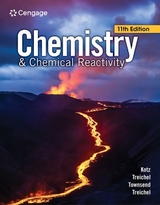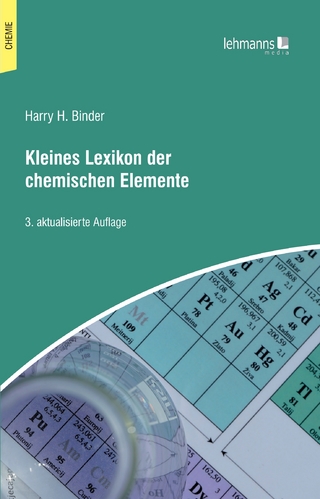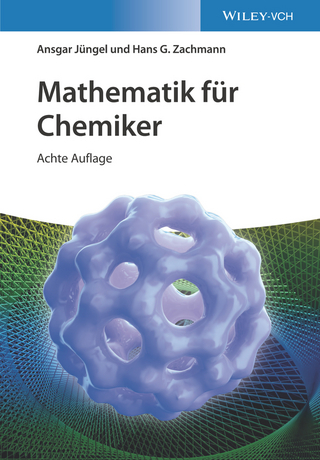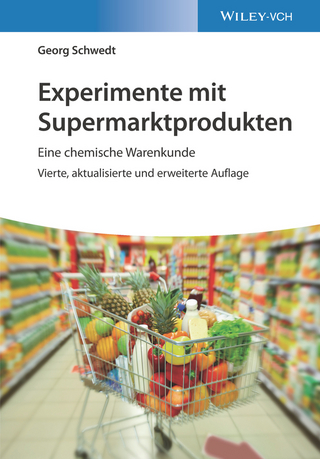
Chemistry and Chemical Reactivity
Brooks/Cole (Verlag)
978-1-337-39907-4 (ISBN)
- Titel erscheint in neuer Auflage
- Artikel merken
Paul M. Treichel received his B.S. degree from the University of Wisconsin in 1958 and his Ph.D. from Harvard University in 1962. After a year of postdoctoral study in London, he assumed a faculty position at the University of Wisconsin–Madison. He served as department chair from 1986 through 1995 and was awarded a Helfaer Professorship in 1996. He has held visiting faculty positions in South Africa (1975) and in Japan (1995). Retiring after 44 years as a faculty member in 2007, he is currently emeritus professor of chemistry. During his faculty career he taught courses in general chemistry, inorganic chemistry, organometallic chemistry and scientific ethics. Professor Treichel's research in organometallic and metal cluster chemistry and in mass spectrometry, aided by 75 graduate and undergraduate students, has led to more than 170 papers in scientific journals. He may be contacted by email at treichelpaul@me.com. David A. Treichel, Professor of Chemistry at Nebraska Wesleyan University, received a B.A. degree from Carleton College. He earned a M.S. and a Ph.D. in analytical chemistry at Northwestern University. After post-doctoral research at the University of Texas in Austin, he joined the faculty at Nebraska Wesleyan University. His research interests are in the fields of electrochemistry and surface-laser spectroscopy. He may be contacted by email at dat@nebrwesleyan.edu. John C. Kotz is a retired State University of New York (SUNY) Distinguished Teaching Professor at the SUNY College at Oneonta. Educated at Washington and Lee University and Cornell University, he held National Institutes of Health postdoctoral appointments at the University of Manchester Institute for Science and Technology in England and at Indiana University. He has co-authored three textbooks in several editions: INORGANIC CHEMISTRY, CHEMISTRY & CHEMICAL REACTIVITY and THE CHEMICAL WORLD. He has also published research on inorganic chemistry and electrochemistry. Professor Kotz was a Fulbright Lecturer and Research Scholar in Portugal in 1979 and a visiting professor there in 1992, as well as a visiting professor at the Institute for Chemical Education (University of Wisconsin, 1991-1992) and at Auckland University in New Zealand (1999). He was an invited speaker on chemical education at conferences in South Africa, New Zealand, Argentina and Brazil. Finally, he was a mentor for the U.S. National Chemistry Olympiad Team for four years. He has received numerous honors, including a SUNY Chancellor's Award (1979), a National Catalyst Award for Excellence in Teaching (1992), the Estee Lectureship in Chemical Education at the University of South Dakota (1998), the Visiting Scientist Award from the Western Connecticut Section of the American Chemical Society (1999) and the first annual Distinguished Education Award from the Binghamton (New York) Section of the American Chemical Society (2001). John R. Townsend is a retired professor of chemistry at West Chester University of Pennsylvania. He completed his B.A. in chemistry as well as the approved program for teacher certification in chemistry at the University of Delaware. After a career teaching high school science and mathematics, he earned his M.S. and Ph.D. in biophysical chemistry at Cornell University, where he also received the DuPont Teaching Award for his work as a teaching assistant. After teaching at Bloomsburg University, he joined the faculty at West Chester University, where he coordinated the chemistry education program for prospective high school teachers and the general chemistry lecture programs, taught undergraduate courses in general chemistry and biochemistry and was the university supervisor for 78 prospective high school chemistry teachers during their student teaching semester. Retiring in 2021, he is currently emeritus professor of chemistry. In 2021, he was also the recipient of the Award for Excellence in Undergraduate Teaching in Chemical Science from the Philadelphia Section of the American Chemistry Society. He may be contacted by email at jtownsend@wcupa.edu.
PART I: THE BASIC TOOLS OF CHEMISTRY.
1. Basic Concepts of Chemistry.
Let's Review: The Tools of Quantitative Chemistry.
2. Atoms, Molecules, and Ions.
3. Chemical Reactions.
4. Stoichiometry: Quantitative Information about Chemical Reactions.
5. Principles of Chemical Reactivity: Energy and Chemical Reactions.
PART II: ATOMS AND MOLECULES.
6. The Structure of Atoms.
7. The Structure of Atoms and Periodic Trends.
8. Bonding and Molecular Structure.
9. Bonding and Molecular Structure – Orbital Hybridization and Molecular Orbitals.
PART III: STATES OF MATTER
10. Gases and Their Properties.
11. Intermolecular Forces and Liquids.
12. The Solid State.
13. Solutions and Their Behavior.
PART IV: THE CONTROL OF CHEMICAL REACTIONS.
14. Chemical Kinetics: The Rates of Chemical Reactions.
15. Principles of Chemical Reactivity: Equilibria.
16. Principles of Chemical Reactivity: The Chemistry of Acids and Bases.
17. Principles of Chemical Reactivity: Other Aspects of Aqueous Equilibria.
18. Principles of Chemical Reactivity: Entropy and Free Energy.
19. Principles of Chemical Reactivity: Electron Transfer Reactions.
PART V: THE CHEMISTRY OF THE ELEMENTS.
20. Environmental Chemistry: Earth's Environment, Energy, and Sustainability.
21. The Chemistry of the Main Group Elements.
22. The Chemistry of the Transition Elements.
23. Carbon: Not Just Another Element.
24. Biochemistry.
25. Nuclear Chemistry.
Appendix A: Using Logarithms and Solving Quadratic Equations.
Appendix B: Some Important Physical Concepts.
Appendix C: Abbreviations and Useful Conversion Factors.
Appendix D: Physical Constants.
Appendix E: A Brief Guide to Naming Organic Compounds.
Appendix F: Values for the Ionization Energies and Electron Attachment Enthalpies of the Elements.
Appendix G: Vapor Pressure of Water at Various Temperatures.
Appendix H: Ionization Constants for Aqueous Weak Acids at 25ºC.
Appendix I: Ionization Constants for Aqueous Weak Bases at 25ºC.
Appendix J: Solubility Product Constants for Some Inorganic Compounds at 25ºC.
Appendix K: Formation Constants for Some Complex Ions in Aqueous Solution at 25°C.
Appendix L: Selected Thermodynamic Values.
Appendix M: Standard Reduction Potentials in Aqueous Solution at 25ºC.
Appendix N: Answers to Check Your Understanding Questions, Applying Chemical Principles Questions, and Selected Study Questions.
| Erscheinungsdatum | 13.02.2018 |
|---|---|
| Verlagsort | CA |
| Sprache | englisch |
| Maße | 223 x 283 mm |
| Gewicht | 2750 g |
| Themenwelt | Naturwissenschaften ► Chemie ► Allgemeines / Lexika |
| ISBN-10 | 1-337-39907-8 / 1337399078 |
| ISBN-13 | 978-1-337-39907-4 / 9781337399074 |
| Zustand | Neuware |
| Haben Sie eine Frage zum Produkt? |
aus dem Bereich



